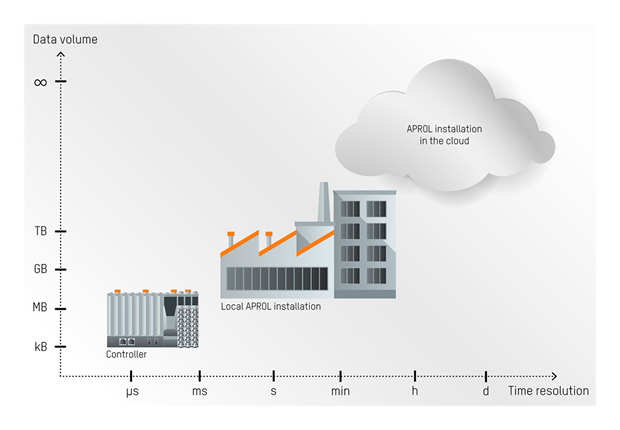Optimising processes with the cloud
Manufacturers are under constant pressure to optimise their processes in order to remain competitive. Increasingly, this means using big data analytics tools to mine enormous volumes of production data. When these tools utilise cloud services, there are a number of important factors to consider.
"Today's manufacturing plants generate gigabytes – sometimes even terabytes – of data every day," says Martin Reichinger, Manager of B&R's Process Automation business unit. The days when this data could be stored and analysed on a single computer are long gone. "More and more companies are moving toward database solutions or internally hosted private clouds."
Operating a private cloud requires an in-house data centre and IT specialists working around the clock to ensure availability. These can be prohibitive costs, particularly for small and medium-sized enterprises, which is why they instead turn to solutions offered by large cloud service providers. "The thing is, you're dealing with huge volumes of what in some cases is very sensitive data," explains Reichinger, "so you don't want to be sending it all unfiltered into a public cloud."

Preprocessing
The alternative is to preprocess the production data and upload only what is necessary into the cloud. This approach, known as edge computing*, retains all the advantages of a public cloud – an IT infrastructure with limitless scalability, world-wide availability and big data analytics services – while at the same time minimising the risks.
"B&R's APROL process control system makes implementing such a solution very easy," notes Reichinger. One instance of APROL is installed on an industrial PC at the production site to handle preprocessing and data compression. A second instance, running on a cloud-based virtual machine, collects data from any number of local APROL systems. "A company with 50 production sites around the world can easily aggregate all of its important data in a single system. Data is compressed to reduce transfer volume, and highly sensitive data can be restricted to local storage only.
Big data analytics
"In the cloud I can take advantage of APROL's built-in analysis and reporting tools, such as our powerful business intelligence suite," highlights Reichinger. The business intelligence platform aggregates and displays a clear overview of analysis results so valuable information is readily available to make well-informed decisions that help optimize production. The database can also be evaluated using data mining tools offered by the public cloud service provider.
To transfer data between local and cloud APROL systems, B&R relies on the vendor-independent OPC UA communication protocol. In locations with high latency times or poor network quality, it is also possible to use AMQP and MQTT to ensure successful transmission of OPC UA data packets.
APROL's integrated APIs can be used to access analysis results generated by the cloud-based APROL. There is also a RESTful API for accessing results generated by the integrated business intelligence suite. Centralized data management allows all information to be accessed remotely from anywhere in the world.
Optimal architecture
This system architecture satisfies all the requirements of connected manufacturing:
- Control level: At the control level, response times and sampling resolution in the sub-millisecond range allow you to do things like sense mechanical vibrations with extremely high precision. Data at this level is stored only temporarily, with volumes in the kilobyte or megabyte range.
- Local APROL: Data is preprocessed and stored in the local APROL system for intermediate archiving. "Here, you have access to the data for hours, days or months," explains Reichinger. Depending on computing power and storage capacity, the data can have a time resolution in the microsecond range. "That allows us to mine real-time data directly in the local APROL system."
- Cloud APROL: For long-term archiving and data mining on a larger time scale, data is aggregated in the cloud, where it can be stored indefinitely and the storage volume is virtually unlimited. "In the cloud you're looking at a time resolution in range of minutes or even seconds," says Reichinger. "That explains why it's still not a good idea to move control tasks into the cloud. Today's standard solutions don't yet ensure the necessary response times and availability."
Globally distributed development teams
APROL lets users enjoy other advantages of the cloud as well. Development of APROL applications can be completed entirely in the cloud. "This is a huge benefit for companies with developers at various locations around the world," explains Reichinger. APROL's built-in support for concurrent engineering allows even larger teams to work efficiently on a shared online project.
Virtual plant in the cloud
"We can even set up an entire virtual plant in the cloud," says Reichinger. In addition to an APROL Runtime Server, this involves setting up the necessary number of simulated controllers and potentially even a simulation of the entire process. "All functionality and even the operability of the plant as a whole can be tested during virtual operation. That saves a whole lot of time and money and prevents many of the surprises that can otherwise pop up when commissioning the actual system."
The cloud can also be used to test new updates before switching to new system software. B&R provides images of all currently supported APROL releases that can be quickly installed and used in the cloud. "With APROL in the cloud, our customers enjoy savings across the board – throughout development, runtime and maintenance," concludes Reichinger.







